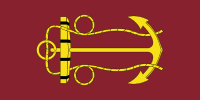Lord High Admiral of the United Kingdom facts for kids
Quick facts for kids Lord High Admiral of the United Kingdom |
|
|---|---|

Flag of the Lord High Admiral
|
|
| Appointer | The monarch |
| Term length | At His Majesty's pleasure |
| Precursor |
|
| Formation |
|
| First holder | The 3rd Earl of Arundel as High Admiral of England, Ireland and Aquitaine |
| Deputy | Vice-Admiral of the United Kingdom |
The Lord High Admiral is a very old and important title in the United Kingdom. It is the ceremonial leader of the Royal Navy, which is the UK's navy. This role started in the 1300s in England. Later, it became a title for Great Britain and then the United Kingdom.
Most people who held this title were not professional naval officers. Instead, they were often members of the British royal family or important people in the royal court. The Lord High Admiral is one of the nine Great Officers of State in England. These are very senior government positions.
Contents
History of the Lord High Admiral Role
The role of Lord High Admiral began way back in 1385. At that time, a person named Richard, Earl of Arundel, was made "Admiral of England." This combined two older jobs: "Admiral of the North" and "Admiral of the West." These older jobs had existed since 1294.
For a while, the "Admiral of the North" and "Admiral of the West" jobs were separate again. But from 1406, "Admirals of England" were appointed all the time. The titles "High Admiral" and "Lord Admiral" were both used. Eventually, they combined to become "Lord High Admiral."
Originally, the Lord High Admiral did not lead ships in battles at sea. Instead, their job was to handle all things related to the sea. This included setting up special courts called Admiralty Courts. These courts dealt with maritime laws and disputes.
During the time of King Henry VIII (1509–1547), the English Navy grew much larger. It became too big for just one Lord High Admiral to manage every day. So, a group of people was put in charge of the navy's daily tasks. This group later became known as the Navy Board.
Famous people like Samuel Pepys were part of the Navy Board. This was during the reign of King Charles II (1660–1685). The Navy Board worked alongside another group called the Board of Admiralty.
From the early 1600s, when a Lord High Admiral was in charge, they had a special group helping them. This was called the Council of the Lord High Admiral. It helped the Lord High Admiral with their duties.
When the Office Was "In Commission"
Sometimes, there wasn't a single person holding the title of Lord High Admiral. When this happened, the job was "put into commission." This meant a group of people, called the Board of Admiralty, took over the duties. The head of this board was called the First Lord of the Admiralty.
This "in commission" arrangement was very common from 1709 onwards. It continued until 1832, when the Board of Admiralty merged with the main Admiralty office.
The title of Lord High Admiral was not officially removed until 1964. In that year, the job of First Lord of the Admiralty was also ended. The responsibilities of the Lords Commissioners of Admiralty were moved to a new group. This new group was called the Admiralty Board. It became a part of the larger Defence Council of the United Kingdom.
After these changes in 1964, the ancient title of Lord High Admiral went back to the ruler personally.
Recent Holders of the Title
Elizabeth II held the title of Lord High Admiral for 47 years. Then, in 2011, she gave the title to her husband, Prince Philip, Duke of Edinburgh. This was to celebrate his 90th birthday. Prince Philip had served in the Royal Navy during the Second World War. He had given up a promising naval career to support Elizabeth as her husband.
Current Status of the Title
When Prince Philip passed away in 2021, it was not immediately clear who held the title. It was unknown if the title of Lord High Admiral went back to the Crown (the monarch). It was also possible it was empty.
The Ministry of Defence said they did not have information on this. However, they suggested the Queen had taken the title back. After Queen Elizabeth II died in 2022, the title was reported to have passed to King Charles III.
Notable Holders of the Title
Over many centuries, many important people held the title of Lord High Admiral. These included powerful dukes, earls, and even kings and queens themselves. They played a key role in the history of England and Great Britain's naval power.
Former Command Flags
The Lord High Admiral used to have special flags to show their authority. These flags would be flown on their ships.
The earliest known rules for these flags came from King Henry VIII in 1545. The Lord High Admiral was told to fly the King's coat of arms flag. This flag went on top of the main mast of the ship. Another flag, with the cross of Saint George, went on top of the front mast.
See also
- Lord High Admiral of Scotland
- Lord High Admiral of the Wash
- Lord High Admiral of Sweden
- List of the First Lords of the Admiralty
Sources
- Houbraken, Jacobus. Thoyras, Paul de Rapin. Vertue, George. (1747). The History of England, A List of Admirals of England (1224-1745). England. Kanpton. P and J.





